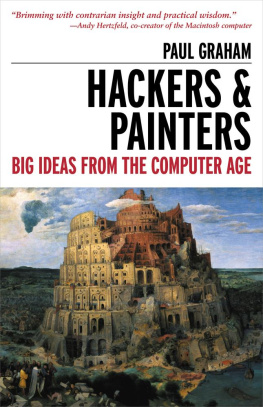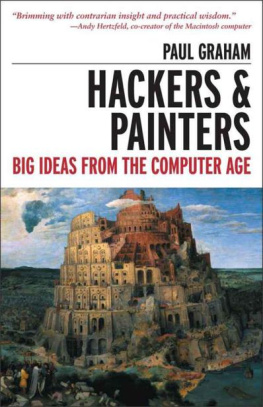Paul Graham - Essays
Here you can read online Paul Graham - Essays full text of the book (entire story) in english for free. Download pdf and epub, get meaning, cover and reviews about this ebook. genre: Computer. Description of the work, (preface) as well as reviews are available. Best literature library LitArk.com created for fans of good reading and offers a wide selection of genres:
Romance novel
Science fiction
Adventure
Detective
Science
History
Home and family
Prose
Art
Politics
Computer
Non-fiction
Religion
Business
Children
Humor
Choose a favorite category and find really read worthwhile books. Enjoy immersion in the world of imagination, feel the emotions of the characters or learn something new for yourself, make an fascinating discovery.

- Book:Essays
- Author:
- Genre:
- Rating:3 / 5
- Favourites:Add to favourites
- Your mark:
- 60
- 1
- 2
- 3
- 4
- 5
Essays: summary, description and annotation
We offer to read an annotation, description, summary or preface (depends on what the author of the book "Essays" wrote himself). If you haven't found the necessary information about the book — write in the comments, we will try to find it.
Essays — read online for free the complete book (whole text) full work
Below is the text of the book, divided by pages. System saving the place of the last page read, allows you to conveniently read the book "Essays" online for free, without having to search again every time where you left off. Put a bookmark, and you can go to the page where you finished reading at any time.
Font size:
Interval:
Bookmark:
Programming Bottom-Up
(This essay is from the introduction to On Lisp.The red text explains the origins of Arc's name.)
It's a long-standing principle of programming style that the functional elements of a program should not be too large. If some component of a program grows beyond the stage where it's readily comprehensible, it becomes a mass of complexity which conceals errors as easily as a big city conceals fugitives. Such software will be hard to read, hard to test, and hard to debug.
In accordance with this principle, a large program must be divided into pieces, and the larger the program, the more it must be divided. How do you divide a program? The traditional approach is called top-down design: you say "the purpose of the program is to do these seven things, so I divide it into seven major subroutines. The first subroutine has to do these four things, so it in turn will have four of its own subroutines," and so on. This process continues until the whole program has the right level of granularity-- each part large enough to do something substantial, but small enough to be understood as a single unit.
Experienced Lisp programmers divide up their programs differently. As well as top-down design, they follow a principle which could be called bottom-up design -- changing the language to suit the problem. In Lisp, you don't just write your program down toward the language, you also build the language up toward your program. As you're writing a program you may think "I wish Lisp had such-and-such an operator." So you go and write it. Afterward you realize that using the new operator would simplify the design of another part of the program, and so on. Language and program evolve together. Like the border between two warring states, the boundary between language and program is drawn and redrawn, until eventually it comes to rest along the mountains and rivers, the natural frontiers of your problem. In the end your program will look as if the language had been designed for it. And when language and program fit one another well, you end up with code which is clear, small, and efficient.
It's worth emphasizing that bottom-up design doesn't mean just writing the same program in a different order. When you work bottom-up, you usually end up with a different program. Instead of a single, monolithic program, you will get a larger language with more abstract operators, and a smaller program written in it. Instead of a lintel, you'll get an arch.
In typical code, once you abstract out the parts which are merely bookkeeping, what's left is much shorter; the higher you build up the language, the less distance you will have to travel from the top down to it. This brings several advantages:
By making the language do more of the work, bottom-up design yields programs which are smaller and more agile. A shorter program doesn't have to be divided into so many components, and fewer components means programs which are easier to read or modify. Fewer components also means fewer connections between components, and thus less chance for errors there. As industrial designers strive to reduce the number of moving parts in a machine, experienced Lisp programmers use bottom-up design to reduce the size and complexity of their programs.
Bottom-up design promotes code re-use. When you write two or more programs, many of the utilities you wrote for the first program will also be useful in the succeeding ones. Once you've acquired a large substrate of utilities, writing a new program can take only a fraction of the effort it would require if you had to start with raw Lisp.
Bottom-up design makes programs easier to read. An instance of this type of abstraction asks the reader to understand a general-purpose operator; an instance of functional abstraction asks the reader to understand a special-purpose subroutine. [1]
Because it causes you always to be on the lookout for patterns in your code, working bottom-up helps to clarify your ideas about the design of your program. If two distant components of a program are similar in form, you'll be led to notice the similarity and perhaps to redesign the program in a simpler way.
Bottom-up design is possible to a certain degree in languages other than Lisp. Whenever you see library functions, bottom-up design is happening. However, Lisp gives you much broader powers in this department, and augmenting the language plays a proportionately larger role in Lisp style-- so much so that Lisp is not just a different language, but a whole different way of programming.
It's true that this style of development is better suited to programs which can be written by small groups. However, at the same time, it extends the limits of what can be done by a small group. In The Mythical Man-Month, Frederick Brooks proposed that the productivity of a group of programmers does not grow linearly with its size. As the size of the group increases, the productivity of individual programmers goes down. The experience of Lisp programming suggests a more cheerful way to phrase this law: as the size of the group decreases, the productivity of individual programmers goes up. A small group wins, relatively speaking, simply because it's smaller. When a small group also takes advantage of the techniques that Lisp makes possible, it can win outright.
Lisp for Web-Based Applications
One of the reasons to use Lisp in writing Web-based applications is that you *can* use Lisp. When you're writing software that is only going to run on your own servers, you can use whatever language you want.
For a long time programmers didn't have a lot of choice about what language to use for writing application programs. Until recently, writing application programs meant writing software to run on desktop computers. In desktop software there was a strong bias toward writing the application in the same language as the operating system. Ten years ago, for all practical purposes, applications were written in C.
With Web-based applications, that changes. You control the servers, and you can write your software in any language you want. You can take it for granted now that you have the source code of both your operating system and your compilers. If there does turn out to be any kind of problem between the language and the OS, you can fix it yourself.
This new freedom is a double-edged sword, however. Having more choices means that you now have to think about which choice to make. It was easier in the old days. If you were in charge of a software project, and some troublesome person suggested writing the software in a different language from whatever you usually used, you could just tell them that it would be impractical, and that would be the end of it.
Now, with server-based applications, everything is changed. You're now subject to market forces in what language you choose. If you try to pretend that nothing has changed, and just use C and C++, like most of our competitors did, you are setting yourself up for a fall. A little startup using a more powerful language will eat your lunch.
Incremental DevelopmentThere is a certain style of software development associated with Lisp. One of its traditions is incremental development: you start by writing, as quickly as possible, a program that does almost nothing. Then you gradually add features to it, but at every step you have working code.
I think this way you get better software, written faster. Everything about Lisp is tuned to this style of programming, because Lisp programmers have worked this way for at least thirty years. The Viaweb editor must be one of the most extreme cases of incremental development. It began with a 120-line program for generating Web sites that I had used in an example in a book that I finished just before we started Viaweb. The Viaweb editor, which eventually grew to be about 25,000 lines of code, grew incrementally from this program. I never once sat down and rewrote the whole thing. I don't think I was ever more than a day or two without running code.
Font size:
Interval:
Bookmark:
Similar books «Essays»
Look at similar books to Essays. We have selected literature similar in name and meaning in the hope of providing readers with more options to find new, interesting, not yet read works.
Discussion, reviews of the book Essays and just readers' own opinions. Leave your comments, write what you think about the work, its meaning or the main characters. Specify what exactly you liked and what you didn't like, and why you think so.









